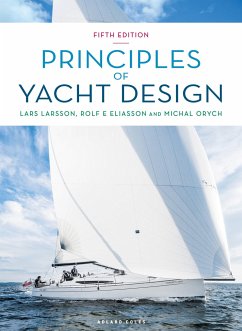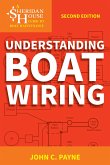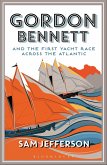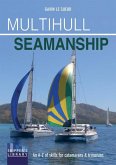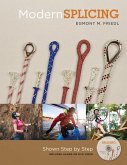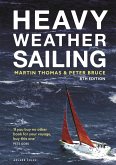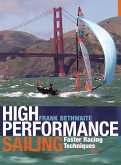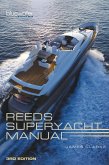- Gebundenes Buch
- Merkliste
- Auf die Merkliste
- Bewerten Bewerten
- Teilen
- Produkt teilen
- Produkterinnerung
- Produkterinnerung
Principles of Yacht Design has established itself as the standard book on the subject for practising designers, naval architecture students, discerning boat owners as well as the boatbuilding industry as a whole. The fifth edition is completely revised and expanded. It examines every aspect of the process of yacht and powerboat design. The new edition includes new findings from recent research in aero and hydrodynamics, as well as covering the most recent changes to building standards. The authors have used a newly built 41-foot performance cruiser to demonstrate the practical application of…mehr
Andere Kunden interessierten sich auch für
![Understanding Boat Wiring Understanding Boat Wiring]() John C. PayneUnderstanding Boat Wiring21,99 €
John C. PayneUnderstanding Boat Wiring21,99 €![Gordon Bennett and the First Yacht Race Across the Atlantic Gordon Bennett and the First Yacht Race Across the Atlantic]() Sam JeffersonGordon Bennett and the First Yacht Race Across the Atlantic16,99 €
Sam JeffersonGordon Bennett and the First Yacht Race Across the Atlantic16,99 €![Multihull Seamanship Multihull Seamanship]() Gavin Le SueurMultihull Seamanship18,99 €
Gavin Le SueurMultihull Seamanship18,99 €![Modern Splicing Modern Splicing]() Egmont M. FriedlModern Splicing47,99 €
Egmont M. FriedlModern Splicing47,99 €![Heavy Weather Sailing 8th Edition Heavy Weather Sailing 8th Edition]() Martin ThomasHeavy Weather Sailing 8th Edition53,99 €
Martin ThomasHeavy Weather Sailing 8th Edition53,99 €![High Performance Sailing High Performance Sailing]() Frank BethwaiteHigh Performance Sailing75,99 €
Frank BethwaiteHigh Performance Sailing75,99 €![Reeds Superyacht Manual Reeds Superyacht Manual]() James ClarkeReeds Superyacht Manual59,99 €
James ClarkeReeds Superyacht Manual59,99 €-
-
-
Principles of Yacht Design has established itself as the standard book on the subject for practising designers, naval architecture students, discerning boat owners as well as the boatbuilding industry as a whole. The fifth edition is completely revised and expanded. It examines every aspect of the process of yacht and powerboat design. The new edition includes new findings from recent research in aero and hydrodynamics, as well as covering the most recent changes to building standards. The authors have used a newly built 41-foot performance cruiser to demonstrate the practical application of yacht design theory. This new edition includes photos of the building process and detailed explanations.
Hinweis: Dieser Artikel kann nur an eine deutsche Lieferadresse ausgeliefert werden.
Hinweis: Dieser Artikel kann nur an eine deutsche Lieferadresse ausgeliefert werden.
Produktdetails
- Produktdetails
- Verlag: Bloomsbury Publishing PLC
- 5 ed
- Seitenzahl: 400
- Erscheinungstermin: 14. Juni 2022
- Englisch
- Abmessung: 269mm x 195mm x 28mm
- Gewicht: 1414g
- ISBN-13: 9781472981929
- ISBN-10: 1472981928
- Artikelnr.: 61261562
- Herstellerkennzeichnung
- Libri GmbH
- Europaallee 1
- 36244 Bad Hersfeld
- gpsr@libri.de
- Verlag: Bloomsbury Publishing PLC
- 5 ed
- Seitenzahl: 400
- Erscheinungstermin: 14. Juni 2022
- Englisch
- Abmessung: 269mm x 195mm x 28mm
- Gewicht: 1414g
- ISBN-13: 9781472981929
- ISBN-10: 1472981928
- Artikelnr.: 61261562
- Herstellerkennzeichnung
- Libri GmbH
- Europaallee 1
- 36244 Bad Hersfeld
- gpsr@libri.de
Lars Larsson is a naval architect and Professor of Hydrodynamics at Chalmers University in Gothenberg, Sweden. Michal Orych is a naval architect and CFD specialist at FLOWTECH International. Rolf Eliasson is a yacht design/construction engineer who runs his own yacht design and production company.
PREFACE TO THE FIFTH EDITION
LIST OF SYMBOLS
INTRODUCTION
1 DESIGN METHODOLOGY
The design spiral
Computer-aided design (CAD)
2 PRELIMINARY CONSIDERATIONS
Choice of boat-type
Intended use
Main dimensions
Cost
Checklist of considerations
Checklist for the YD-41
3 HULL GEOMETRY
Definitions
Lines drawing
Tools
Work plan
Computer-aided design of hulls
4 HYDROSTATICS AND STABILITY
Calculation of areas
Wetted surface
Displacement
Centre of buoyancy
Water plane area
Transverse and longitudinal stability at small angles
Transverse stability at large angles of heel
Curve of static stability
Rolling
Influence of waves on the righting moment
Stability statistics
Assessment of seaworthiness
5 HULL DESIGN
Forces and moments on a sailing yacht
Resistance components
Viscous resistance: basic concepts
Frictional resistance
Viscous pressure resistance
Roughness
Wave resistance: basic concepts
Wave and residuary resistance
Heel resistance
Added resistance in waves
Other seakeeping aspects
Hull statistics
6 KEEL AND RUDDER DESIGN
Flow around a wing
Definition of the keel planform
Classical wing theory
Tip shape
Lift and induced resistance of the yacht
Advanced planform design
Canting keels
Evaluation of some planform concepts
Definition of the section
Three useful NACA sections
Influence of shape on section characteristics
Some practical conclusions regarding section shape
Influence of deviations from the theoretical section shape
Advanced section design
Statistics on keel and rudder area
The YD-41
7 SAIL AND RIG DESIGN
Flow around sails
Planform
Sail camber
Mast interference
Means for reducing mast disturbances
Streamlining
A practical model for sail and rig aerodynamics
Sail statistics
8 BALANCE
Effect of heel
Good balance
Centre of effort of the underwater body
Centre of effort of the sails
Lead
Rudder balance
9 PROPELLER AND ENGINE
Resistance in calm and rough weather
Propeller characteristics
Design of an optimum propeller
Performance of the non-optimum propeller
Check of blade area
Propeller resistance
10 HIGH SPEED HYDRODYNAMICS
Planing
Deadrise
Forces on a planing hull
Spray rails, stepped bottoms and transom flaps
Dynamic stability
Alternative propulsion devices
An example
11 RIG CONSTRUCTION
Definitions and scope of the standard
Forces on the shrouds
Forces on the stays
Comparison between wire and rod
Transverse mast stiffness
Longitudinal mast stiffness
Fractional mast top
Boom
Spreaders
Holes in the mast
The YD-41 rig
12 HULL CONSTRUCTION
Concepts in structural mechanics
Global loads
Local hydrostatic loads
Local hydrodynamic loads
Transverse load distribution
Local deformations
Forces from the keel
Forces from grounding
Forces from the rudder
Summary of loadings
13 MATERIALS
Glass reinforcement
Wet laminates
Fatigue
Exotic laminates
Sandwich
Typical sandwich buckling
Sandwich bending
Sandwich in practice
Final remarks
14 SCANTLING DETERMINATION
Structure of the ISO Standard
Basic laminate
Design loads for the bottom
Design loads for the topsides
Design loads for the decks, superstructures and bulkheads
Design loads for the internals
Longitudinal impact distribution factor
Area reduction factor
Panel calculation
Stiffener calculation
Spade rudder stock
Chainplates and keelbolts
Sandwich construction
The YD-41 scantlings
15 LAYOUT
Generic space requirements
Accommodation
Deck layout
16 DESIGN EVALUATION
Non-dimensional parameters
The Velocity Prediction Program (VPP)
Towing tank testing
Wind tunnel testing
Computational Fluid Dynamics (CFD)
APPENDIX 1: Main particulars of the YD-41
APPENDIX 2: Weight calculation
APPENDIX 3: STIX calculation
REFERENCES
INDEX
LIST OF SYMBOLS
INTRODUCTION
1 DESIGN METHODOLOGY
The design spiral
Computer-aided design (CAD)
2 PRELIMINARY CONSIDERATIONS
Choice of boat-type
Intended use
Main dimensions
Cost
Checklist of considerations
Checklist for the YD-41
3 HULL GEOMETRY
Definitions
Lines drawing
Tools
Work plan
Computer-aided design of hulls
4 HYDROSTATICS AND STABILITY
Calculation of areas
Wetted surface
Displacement
Centre of buoyancy
Water plane area
Transverse and longitudinal stability at small angles
Transverse stability at large angles of heel
Curve of static stability
Rolling
Influence of waves on the righting moment
Stability statistics
Assessment of seaworthiness
5 HULL DESIGN
Forces and moments on a sailing yacht
Resistance components
Viscous resistance: basic concepts
Frictional resistance
Viscous pressure resistance
Roughness
Wave resistance: basic concepts
Wave and residuary resistance
Heel resistance
Added resistance in waves
Other seakeeping aspects
Hull statistics
6 KEEL AND RUDDER DESIGN
Flow around a wing
Definition of the keel planform
Classical wing theory
Tip shape
Lift and induced resistance of the yacht
Advanced planform design
Canting keels
Evaluation of some planform concepts
Definition of the section
Three useful NACA sections
Influence of shape on section characteristics
Some practical conclusions regarding section shape
Influence of deviations from the theoretical section shape
Advanced section design
Statistics on keel and rudder area
The YD-41
7 SAIL AND RIG DESIGN
Flow around sails
Planform
Sail camber
Mast interference
Means for reducing mast disturbances
Streamlining
A practical model for sail and rig aerodynamics
Sail statistics
8 BALANCE
Effect of heel
Good balance
Centre of effort of the underwater body
Centre of effort of the sails
Lead
Rudder balance
9 PROPELLER AND ENGINE
Resistance in calm and rough weather
Propeller characteristics
Design of an optimum propeller
Performance of the non-optimum propeller
Check of blade area
Propeller resistance
10 HIGH SPEED HYDRODYNAMICS
Planing
Deadrise
Forces on a planing hull
Spray rails, stepped bottoms and transom flaps
Dynamic stability
Alternative propulsion devices
An example
11 RIG CONSTRUCTION
Definitions and scope of the standard
Forces on the shrouds
Forces on the stays
Comparison between wire and rod
Transverse mast stiffness
Longitudinal mast stiffness
Fractional mast top
Boom
Spreaders
Holes in the mast
The YD-41 rig
12 HULL CONSTRUCTION
Concepts in structural mechanics
Global loads
Local hydrostatic loads
Local hydrodynamic loads
Transverse load distribution
Local deformations
Forces from the keel
Forces from grounding
Forces from the rudder
Summary of loadings
13 MATERIALS
Glass reinforcement
Wet laminates
Fatigue
Exotic laminates
Sandwich
Typical sandwich buckling
Sandwich bending
Sandwich in practice
Final remarks
14 SCANTLING DETERMINATION
Structure of the ISO Standard
Basic laminate
Design loads for the bottom
Design loads for the topsides
Design loads for the decks, superstructures and bulkheads
Design loads for the internals
Longitudinal impact distribution factor
Area reduction factor
Panel calculation
Stiffener calculation
Spade rudder stock
Chainplates and keelbolts
Sandwich construction
The YD-41 scantlings
15 LAYOUT
Generic space requirements
Accommodation
Deck layout
16 DESIGN EVALUATION
Non-dimensional parameters
The Velocity Prediction Program (VPP)
Towing tank testing
Wind tunnel testing
Computational Fluid Dynamics (CFD)
APPENDIX 1: Main particulars of the YD-41
APPENDIX 2: Weight calculation
APPENDIX 3: STIX calculation
REFERENCES
INDEX
PREFACE TO THE FIFTH EDITION
LIST OF SYMBOLS
INTRODUCTION
1 DESIGN METHODOLOGY
The design spiral
Computer-aided design (CAD)
2 PRELIMINARY CONSIDERATIONS
Choice of boat-type
Intended use
Main dimensions
Cost
Checklist of considerations
Checklist for the YD-41
3 HULL GEOMETRY
Definitions
Lines drawing
Tools
Work plan
Computer-aided design of hulls
4 HYDROSTATICS AND STABILITY
Calculation of areas
Wetted surface
Displacement
Centre of buoyancy
Water plane area
Transverse and longitudinal stability at small angles
Transverse stability at large angles of heel
Curve of static stability
Rolling
Influence of waves on the righting moment
Stability statistics
Assessment of seaworthiness
5 HULL DESIGN
Forces and moments on a sailing yacht
Resistance components
Viscous resistance: basic concepts
Frictional resistance
Viscous pressure resistance
Roughness
Wave resistance: basic concepts
Wave and residuary resistance
Heel resistance
Added resistance in waves
Other seakeeping aspects
Hull statistics
6 KEEL AND RUDDER DESIGN
Flow around a wing
Definition of the keel planform
Classical wing theory
Tip shape
Lift and induced resistance of the yacht
Advanced planform design
Canting keels
Evaluation of some planform concepts
Definition of the section
Three useful NACA sections
Influence of shape on section characteristics
Some practical conclusions regarding section shape
Influence of deviations from the theoretical section shape
Advanced section design
Statistics on keel and rudder area
The YD-41
7 SAIL AND RIG DESIGN
Flow around sails
Planform
Sail camber
Mast interference
Means for reducing mast disturbances
Streamlining
A practical model for sail and rig aerodynamics
Sail statistics
8 BALANCE
Effect of heel
Good balance
Centre of effort of the underwater body
Centre of effort of the sails
Lead
Rudder balance
9 PROPELLER AND ENGINE
Resistance in calm and rough weather
Propeller characteristics
Design of an optimum propeller
Performance of the non-optimum propeller
Check of blade area
Propeller resistance
10 HIGH SPEED HYDRODYNAMICS
Planing
Deadrise
Forces on a planing hull
Spray rails, stepped bottoms and transom flaps
Dynamic stability
Alternative propulsion devices
An example
11 RIG CONSTRUCTION
Definitions and scope of the standard
Forces on the shrouds
Forces on the stays
Comparison between wire and rod
Transverse mast stiffness
Longitudinal mast stiffness
Fractional mast top
Boom
Spreaders
Holes in the mast
The YD-41 rig
12 HULL CONSTRUCTION
Concepts in structural mechanics
Global loads
Local hydrostatic loads
Local hydrodynamic loads
Transverse load distribution
Local deformations
Forces from the keel
Forces from grounding
Forces from the rudder
Summary of loadings
13 MATERIALS
Glass reinforcement
Wet laminates
Fatigue
Exotic laminates
Sandwich
Typical sandwich buckling
Sandwich bending
Sandwich in practice
Final remarks
14 SCANTLING DETERMINATION
Structure of the ISO Standard
Basic laminate
Design loads for the bottom
Design loads for the topsides
Design loads for the decks, superstructures and bulkheads
Design loads for the internals
Longitudinal impact distribution factor
Area reduction factor
Panel calculation
Stiffener calculation
Spade rudder stock
Chainplates and keelbolts
Sandwich construction
The YD-41 scantlings
15 LAYOUT
Generic space requirements
Accommodation
Deck layout
16 DESIGN EVALUATION
Non-dimensional parameters
The Velocity Prediction Program (VPP)
Towing tank testing
Wind tunnel testing
Computational Fluid Dynamics (CFD)
APPENDIX 1: Main particulars of the YD-41
APPENDIX 2: Weight calculation
APPENDIX 3: STIX calculation
REFERENCES
INDEX
LIST OF SYMBOLS
INTRODUCTION
1 DESIGN METHODOLOGY
The design spiral
Computer-aided design (CAD)
2 PRELIMINARY CONSIDERATIONS
Choice of boat-type
Intended use
Main dimensions
Cost
Checklist of considerations
Checklist for the YD-41
3 HULL GEOMETRY
Definitions
Lines drawing
Tools
Work plan
Computer-aided design of hulls
4 HYDROSTATICS AND STABILITY
Calculation of areas
Wetted surface
Displacement
Centre of buoyancy
Water plane area
Transverse and longitudinal stability at small angles
Transverse stability at large angles of heel
Curve of static stability
Rolling
Influence of waves on the righting moment
Stability statistics
Assessment of seaworthiness
5 HULL DESIGN
Forces and moments on a sailing yacht
Resistance components
Viscous resistance: basic concepts
Frictional resistance
Viscous pressure resistance
Roughness
Wave resistance: basic concepts
Wave and residuary resistance
Heel resistance
Added resistance in waves
Other seakeeping aspects
Hull statistics
6 KEEL AND RUDDER DESIGN
Flow around a wing
Definition of the keel planform
Classical wing theory
Tip shape
Lift and induced resistance of the yacht
Advanced planform design
Canting keels
Evaluation of some planform concepts
Definition of the section
Three useful NACA sections
Influence of shape on section characteristics
Some practical conclusions regarding section shape
Influence of deviations from the theoretical section shape
Advanced section design
Statistics on keel and rudder area
The YD-41
7 SAIL AND RIG DESIGN
Flow around sails
Planform
Sail camber
Mast interference
Means for reducing mast disturbances
Streamlining
A practical model for sail and rig aerodynamics
Sail statistics
8 BALANCE
Effect of heel
Good balance
Centre of effort of the underwater body
Centre of effort of the sails
Lead
Rudder balance
9 PROPELLER AND ENGINE
Resistance in calm and rough weather
Propeller characteristics
Design of an optimum propeller
Performance of the non-optimum propeller
Check of blade area
Propeller resistance
10 HIGH SPEED HYDRODYNAMICS
Planing
Deadrise
Forces on a planing hull
Spray rails, stepped bottoms and transom flaps
Dynamic stability
Alternative propulsion devices
An example
11 RIG CONSTRUCTION
Definitions and scope of the standard
Forces on the shrouds
Forces on the stays
Comparison between wire and rod
Transverse mast stiffness
Longitudinal mast stiffness
Fractional mast top
Boom
Spreaders
Holes in the mast
The YD-41 rig
12 HULL CONSTRUCTION
Concepts in structural mechanics
Global loads
Local hydrostatic loads
Local hydrodynamic loads
Transverse load distribution
Local deformations
Forces from the keel
Forces from grounding
Forces from the rudder
Summary of loadings
13 MATERIALS
Glass reinforcement
Wet laminates
Fatigue
Exotic laminates
Sandwich
Typical sandwich buckling
Sandwich bending
Sandwich in practice
Final remarks
14 SCANTLING DETERMINATION
Structure of the ISO Standard
Basic laminate
Design loads for the bottom
Design loads for the topsides
Design loads for the decks, superstructures and bulkheads
Design loads for the internals
Longitudinal impact distribution factor
Area reduction factor
Panel calculation
Stiffener calculation
Spade rudder stock
Chainplates and keelbolts
Sandwich construction
The YD-41 scantlings
15 LAYOUT
Generic space requirements
Accommodation
Deck layout
16 DESIGN EVALUATION
Non-dimensional parameters
The Velocity Prediction Program (VPP)
Towing tank testing
Wind tunnel testing
Computational Fluid Dynamics (CFD)
APPENDIX 1: Main particulars of the YD-41
APPENDIX 2: Weight calculation
APPENDIX 3: STIX calculation
REFERENCES
INDEX

